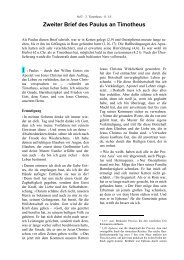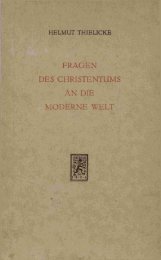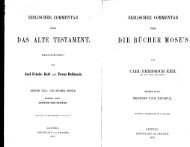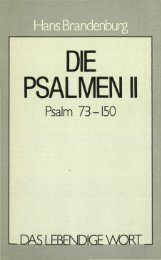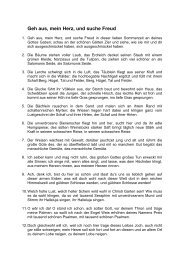You also want an ePaper? Increase the reach of your titles
YUMPU automatically turns print PDFs into web optimized ePapers that Google loves.
DNA<br />
– information storage<br />
technology way beyond<br />
computers<br />
The body’s most precious substance is stored<br />
deep inside the cells, in the tiny nucleus, namely<br />
the genetic information, known as the genome.<br />
If this information were to be written down<br />
using the alphabet, it would fill one thousand<br />
books, each having 1000 pages with 3,000 letters<br />
to the page. The human genome (inherited material)<br />
consists of three thousand million genetic<br />
“letters”. If all these letters were typed in one line,<br />
it would extend from the North Pole to the equator.<br />
A good typist working 220 eight-hour days<br />
per year, at a typing speed of 300 letters a<br />
minute, would require 95 years for this task –<br />
much longer than her entire working life!<br />
Taking into account the time required for planning<br />
and testing up to the implementation of the<br />
final system, a scientific programmer produces<br />
40 symbols of program code per day on average.<br />
It would thus require a team of 8,000 programmers,<br />
devoting their entire career to this project,<br />
to program the human genome. But no human<br />
programmer knows how to structure this program<br />
and fit it into a DNA fibre measuring only<br />
one metre if stretched out. 1<br />
The DNA molecule. Schematic representation of the<br />
three-dimensional double helical structure of DNA<br />
(DNA = desoxyribonucleic acid). Two polynucleotide<br />
strands are spirally wound round each other, thus forming<br />
a double helix. The base pairs, coupled by means of<br />
hydrogen bridges, are arranged in a plane perpendicular<br />
to the helical axis. Base pairs comprise either adenine<br />
with thymine, or cytosine with guanine. It follows that<br />
the molar quantity ratios are A:T = C:G = 1:1. The distance<br />
from one spiral loop to the next is 3.4 nanometres<br />
(nm), the diameter is 2 nm, and the distance between the<br />
stacked base pairs is 0.34 nm (1 nm = 10 -9 m = one thousand<br />
millionth of a metre or 1 millionth of a millimetre).<br />
Storage density: The storage medium of genetic<br />
information is the double stranded DNA (chemical<br />
name: de(s)oxyribonucleic acid; see diagram<br />
on page 74). The volume 2 of human DNA is<br />
extremely small, only three thousand millionths<br />
of a cubic millimetre (3 x 10 -9 mm 3 ). Its storage<br />
density is enormous, many magnitudes higher<br />
than the latest computer chips. In fact, it is the<br />
highest known. Let us try to visualise it:<br />
If one could stretch out the head of a pin measuring<br />
2 mm in diameter until it became a thread<br />
having the same thickness as a DNA molecule, it<br />
would be 33 times as long as the equator! Could<br />
you have imagined that?<br />
If the genome information were in printed form,<br />
it would require 12,000 paperbacks of 160 pages<br />
each. Compared to the current 16 Megabit computer<br />
chips, a human DNA strand stores an<br />
amazing 1,400 times as much information.<br />
To get a further idea of the almost unimaginable<br />
density of information in the DNA molecule,<br />
imagine you had just enough DNA to fit into a<br />
pinhead. Now imagine the information contained<br />
in an ordinary pocket paperback of 160 pages.<br />
How many such lots of information could you<br />
store in this tiny amount of DNA? The answer is<br />
15 x 10 12 (15 million million). If you actually had<br />
that many of these books and put them on top of<br />
one another in a pile, this would be 500 times as<br />
high as the distance (384,000 km) from the earth<br />
to the moon! To put it another way – if you distributed<br />
these books equally among the roughly<br />
6 billion people on Earth, each person would get<br />
2,500 copies!<br />
1<br />
Total length of the DNA strand (germ cell):<br />
L is equal to (the number of letters) x (the distance<br />
between letters)<br />
= 3 x 10 9 x 0.34 x 10 -9 m = 1.02 m<br />
2<br />
Volume of the DNA strand (germ cell):<br />
V = (π/4) x (2 x 10 -9 m) 2 x 1.02 m = 3.2 x 10 -18 m 3<br />
= 3.2 x 10 -9 mm 3 = 3.2 µm 3<br />
1 m 3 (cubic metre) = 10 9 mm 3 (cubic millimetres)<br />
1 mm 3 = 10 9 µm 3 (cubic micrometres)<br />
75




